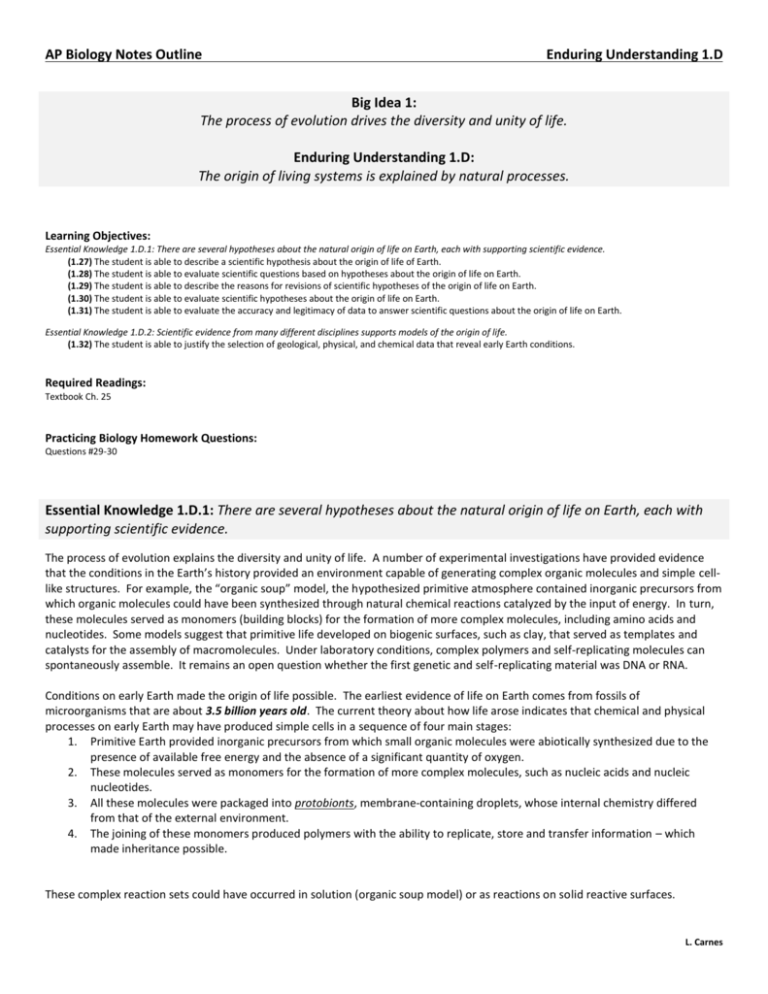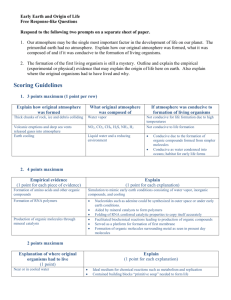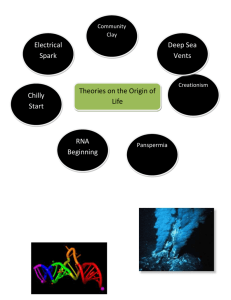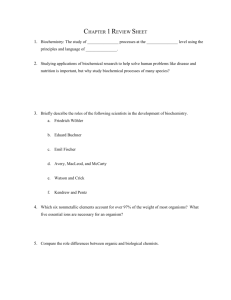AP Biology Notes Outline Enduring Understanding 1.D Big Idea 1
advertisement

AP Biology Notes Outline Enduring Understanding 1.D Big Idea 1: The process of evolution drives the diversity and unity of life. Enduring Understanding 1.D: The origin of living systems is explained by natural processes. Learning Objectives: Essential Knowledge 1.D.1: There are several hypotheses about the natural origin of life on Earth, each with supporting scientific evidence. (1.27) The student is able to describe a scientific hypothesis about the origin of life of Earth. (1.28) The student is able to evaluate scientific questions based on hypotheses about the origin of life on Earth. (1.29) The student is able to describe the reasons for revisions of scientific hypotheses of the origin of life on Earth. (1.30) The student is able to evaluate scientific hypotheses about the origin of life on Earth. (1.31) The student is able to evaluate the accuracy and legitimacy of data to answer scientific questions about the origin of life on Earth. Essential Knowledge 1.D.2: Scientific evidence from many different disciplines supports models of the origin of life. (1.32) The student is able to justify the selection of geological, physical, and chemical data that reveal early Earth conditions. Required Readings: Textbook Ch. 25 Practicing Biology Homework Questions: Questions #29-30 Essential Knowledge 1.D.1: There are several hypotheses about the natural origin of life on Earth, each with supporting scientific evidence. The process of evolution explains the diversity and unity of life. A number of experimental investigations have provided evidence that the conditions in the Earth’s history provided an environment capable of generating complex organic molecules and simple celllike structures. For example, the “organic soup” model, the hypothesized primitive atmosphere contained inorganic precursors from which organic molecules could have been synthesized through natural chemical reactions catalyzed by the input of energy. In turn, these molecules served as monomers (building blocks) for the formation of more complex molecules, including amino acids and nucleotides. Some models suggest that primitive life developed on biogenic surfaces, such as clay, that served as templates and catalysts for the assembly of macromolecules. Under laboratory conditions, complex polymers and self-replicating molecules can spontaneously assemble. It remains an open question whether the first genetic and self-replicating material was DNA or RNA. Conditions on early Earth made the origin of life possible. The earliest evidence of life on Earth comes from fossils of microorganisms that are about 3.5 billion years old. The current theory about how life arose indicates that chemical and physical processes on early Earth may have produced simple cells in a sequence of four main stages: 1. Primitive Earth provided inorganic precursors from which small organic molecules were abiotically synthesized due to the presence of available free energy and the absence of a significant quantity of oxygen. 2. These molecules served as monomers for the formation of more complex molecules, such as nucleic acids and nucleic nucleotides. 3. All these molecules were packaged into protobionts, membrane-containing droplets, whose internal chemistry differed from that of the external environment. 4. The joining of these monomers produced polymers with the ability to replicate, store and transfer information – which made inheritance possible. These complex reaction sets could have occurred in solution (organic soup model) or as reactions on solid reactive surfaces. L. Carnes There is scientific evidence that Earth and the other planets of the solar system formed about 4.6 billion years ago. • The first atmosphere was probably thick with water vapor; along with various compounds released by volcanic eruptions, including nitrogen and oxides, carbon dioxide, methane, ammonia, hydrogen, and hydrogen sulfide. • As Earth cooled, the water vapor condensed into the oceans, and much of the hydrogen quickly escaped into space. In the 1920s, Russian and British chemists Oparin and Haldane hypothesized that Earth’s early atmosphere was a reducing (electronadding) environment, in which organic compounds could have formed from simple molecules. They suggested that the early oceans were a solution of organic molecules, a “primitive soup” from which life arose. The presence of small organic molecules, such as amino acids, is not sufficient for the emergence of life as we know it. Every cell has an assortment of macromolecules – including enzymes and other proteins and nucleic acids that are essential for self-replication. Experiments suggest that such molecules could have formed in early Earth. • Some models suggest that primitive life developed on biogenic surfaces, such as clay, that served as templates and catalysts for assembly of macromolecules. • By dripping solutions of amino acids into hot sand, clay, or rock, researchers have been able to produce amino acid polymers. The polymers formed spontaneously, without the help of enzymes or ribosomes. • It is possible that such polymers may have acted as weak catalysts for a variety of reactions on early Earth. The necessary conditions for replication and metabolism early in life’s history may have been met by protobionts. Protobionts are aggregates of abiotically produced molecules surrounded by a membrane or membrane-like structure. • Protobionts may exhibit some properties of life, such as simple reproduction and metabolism, as well as the maintenance of an internal chemical environment different from that of their surroundings. • Experiments demonstrate that protobionts could have formed spontaneously from abiotically produced organic compounds. Two key properties of life are accurate replication and metabolism. Neither property can exist without the other. • DNA replication requires elaborate enzymatic machinery, along with supplies of nucleotides provided by the cell’s metabolism. • Miller-Urey type experiments have yielded some of the nitrogenous bases of DNA and RNA, but have not produced anything like nucleotides. If the building blocks of nucleic acids were not a part of the early organic soup, self-replicating molecules and a metabolism-like source for building blocks must have happened together. How did that happen? Diagram A: This liposome is “giving birth” to smaller liposomes. Diagram B: If enzymes – in this case phosphatase and amylase – are included in the solution from which the droplets self-assemble, some liposomes can carry out simple metabolic reactions and export the products. LIPOSOME: small membrane-bounded droplets According to the RNA World hypothesis, the first genetic material was most likely RNA, not DNA. RNA molecules called ribozymes have been found to catalyze many different reactions: for example, ribozymes can make complementary copies of short stretches of their own sequence or other short pieces of RNA. • • • • • • • Early protobionts with self-replicating, catalytic RNA would have been more effective at using resources and would have increased in number through natural selection. The early genetic material might have formed an “RNA world”. Once RNA sequences that carried genetic information appeared in protobionts, many further changes would have been possible. RNA could have provided the template on which DNA nucleotides were assembled. Since DNA is much more stable than RNA, it can be replicated more accurately. Accurate replication was a necessity as genomes grew larger through gene duplication and other processes. After DNA appeared, perhaps RNA molecules began to take on their present-day roles as intermediates in the translation of genetic programs. The stage would have now been set for a blossoming of diverse life forms – a change we see well documented in the fossil record. Essential Knowledge 1.D.2: Scientific evidence from many different disciplines supports models of the origin of life. Fossils in all parts of the world tell a similar, surprising story: past organisms were very different from those now alive. The sweeping changes in life on Earth revealed by fossils illustrate macroevolution, the pattern of evolution over large time scales. Specific examples of macroevolutionary change include the origin of key biochemical processes such as photosynthesis, the emergence of the first terrestrial vertebrates, and the long-term impact of a mass extinction on the diversity of life. Taken together, such changes provide a grand view of the evolutionary history of life on Earth. The Earth formed approximately 4.6 billion years ago, and the environment was too hostile for life until 3.9 billion years ago. The earliest fossil evidence for life dates to 3.5 billion years ago. Taken together, this evidence provides a plausible range of dates when the origin of life could have occurred. The fossil record is the sequence in which fossils appear in the layers of sedimentary rock that constitute Earth’s surface. • The fossil record reveals changes in the history of life on earth. Fossils can also document how new groups of organisms arose from previously existing ones. • Sedimentary rocks are deposited into layers called strata and are the richest source of fossils. • Few individuals have fossilized, and even fewer have been discovered. • The fossil record is biased in favor of species that existed for a long time; were abundant and widespread, and had parts capable of fossilizing. Key events in life’s history include the origins of single-celled and multi-celled organisms and the colonization of land. The study of fossils has helped geologists to establish a geologic record of Earth’s history. Each era represents a distinct age in the history of Earth and its life. The boundaries between the eras correspond to major extinction evens seen in the fossil record, when many forms of life disappeared and were replaced by forms that evolved from the survivors. Life on Earth began about 3.5 billion years ago. At that point in the development of the Earth, the atmosphere was very different from what it is today. As opposed to the current atmosphere, which is mostly nitrogen and oxygen, the early Earth atmosphere contained mostly hydrogen, water, ammonia, and methane. In experiments, scientists have showed that the electrical discharges of lightning, radioactivity, and ultraviolet light caused the elements in the early Earth atmosphere to form the basic molecules of biological chemistry, such as nucleotides, simple proteins, and ATP. It seems likely, then, that the Earth was covered in a hot, thin soup of water and organic materials. Over time, the molecules became more complex and began to collaborate to run metabolic processes. Eventually, the first cells came into being. These cells were heterotrophs, which could not produce their own food and instead fed on the organic material from the primordial soup. (These heterotrophs give this theory its name.) The anaerobic metabolic processes of the heterotrophs released carbon dioxide into the atmosphere, which allowed for the evolution of photosynthetic autotrophs, which could use light and CO2 to produce their own food. The autotrophs released oxygen into the atmosphere. For most of the original anaerobic heterotrophs, oxygen proved poisonous. The few heterotrophs that survived the change in environment generally evolved the capacity to carry out aerobic respiration. Over the subsequent billions of years, the aerobic autotrophs and heterotrophs became the dominant life-forms on the planet and evolved into all of the diversity of life now visible on Earth. The earliest living organisms were prokaryotes. • About 2.7 billion years ago, oxygen began to accumulate in Earth’s atmosphere as a result of photosynthesis. • Eukaryotes appeared about 2.1 billion years ago. • Multicellular eukaryotes evolved about 1.2 billion years ago. • The colonization of land occurred about 500 million years ago, when plants, fungi, and animals began to appear on Earth. • The earliest evidence of life (3.5 billion years ago) comes from fossilized stromatolites. • These are layered rocks that form when certain prokaryotes bind thin films of sediment together. • Early prokaryotes were Earth’s sole inhabitants from about 3.5 to 2.1 billion years ago. • These prokaryotes transformed life on our planet. Photosynthesis and the Oxygen Revolution • Most atmospheric oxygen gas is of biological origin, produced during the water-splitting steps of photosynthesis. • When oxygenic photosynthesis first evolved, the free O2 produced probably dissolved in the surrounding water until it reached a high enough concentration to react with dissolved iron. • This would have caused the iron to precipitate as iron oxide, which accumulated as sediments. Once all of the dissolved iron had precipitated, additional O2 dissolved in the water until the seas and lakes became saturated. • After this, O2 began to “gas out” of the water and enter the atmosphere. • This “gas out” change left its mark in the rusting of iron-rich terrestrial rocs. • These sediments were compressed into banded iron formations, red layers of rock containing iron oxide that are a source of iron today. • The “oxygen revolution” had an enormous impact on life. • In certain chemical forms, oxygen attacks chemical bonds and can inhibit enzymes and damage cells. • As a result the rising concentrations of atmospheric O2 probably doomed many prokaryotic groups. • Some species survived in anaerobic habitats, where we find their descendants living today. • Among other survivors, diverse adaptations to the changing atmosphere evolved, including cellular respiration, which uses O2 in the process of harvesting the energy stored in organic molecules. Endosymbiosis and the First Eukaryotic Life Forms • The oldest fossils of eukaryotic cells date back 2.1 billion years. • The hypothesis of endosymbiosis proposes that mitochondria and plastids (chloroplasts and related organelles) were formerly small prokaryotes living within larger host cells • An endosymbiont is a cell that lives within a host cell. Model for origin of eukaryotes (A) endomembrane system of eukaryotes may have evolved from specialized infoldings of plasma membrane of ancestral prokaryotes (B) chloroplasts are descendants of photosynthetic prokaryotes, probably cyanobacteria - proposed ancestors of mitochondria were endosymbiotic bacteria that were aerobic heterotrophs - may have first gained entry into larger cells as undigested prey or internal parasites Be a good skeptic! Where’s the evidence? The endosymbiotic hypothesis proposes that mitochondria and plastids (chloroplasts) were formerly small prokaryotes that began living within larger cells. Evidence for this hypothesis includes: • Both organelles have enzymes and transport systems homologous to those found in the plasma membranes of living prokaryotes. • Both replicate by a splitting process similar to prokaryotes. • Both contain a single, circular DNA molecule, not associated with histone proteins. • Both have their own ribosomes which translate their DNA into proteins. The Origin of Multicellularity The evolution of eukaryotic cells allowed for a greater range of unicellular forms. A second wave of diversification occurred when multicellularity evolved and gave rise to algae, plants, fungi, and animals. • Comparisons of DNA sequences date the common ancestor of multicellular eukaryotes to 1.5 billion years ago. • The oldest known fossils of multicellular eukaryotes are of small algae that lived about 1.2 billion years ago. • Molecular and genetic evidence from extant and extinct organisms indicates that all organisms on Earth share a common ancestral origin of life. - Common molecular building blocks (carbohydrates, lipids, proteins, nucleic acids) - Common genetic code (DNA or RNA) The Rise and Fall of Dominant Groups Anaerobic prokaryotes originated, flourished, and then declined as the oxygen content of the atmosphere rose. Billions of years later, the first tetrapods emerged from the sea, giving rise to amphibians that went on to dominate life on land for 100 millions years – until other tetrapods (dinosaurs and later, mammals) replaced them as the dominant terrestrial vertebrates. • These and other major changes in life on Earth have been influenced by large-scale processes such as continental drift, mass extinctions, and adaptive radiations. • The rise and fall of dominant groups reflect continental drift, mass extinctions, and adaptive radiations. Continental Drift Continental drift alters habitats in which organisms live and promotes allopatric speciation on a grand scale: 1. CD alters habitats in which organisms live – which can drive many species to extinction and provide new opportunities for groups of organisms that survive the crisis. 2. CD facilitates climate change which can cause organisms to adapt, move to new locations, or become extinct. 3. CD promotes allopatric speciation – when continents break apart, regions that were connected become geographically isolated. This geographic isolation provides a barrier to gene flow between organisms that may have once been a single species. As they drift further apart, each continent becomes an evolutionary arena. 4. Continental drift can explain puzzles about the geographic distribution of species: • Australia flora and fauna contrast sharply with those of the rest of the world. Marsupial mammals fill ecological roles in Australia analogous to those filled by eutherians (placental mammals) on other continents. • Marsupials probably originated in what is now Asia and N. America and reached Australia via S. America and Antarctica while the continents were still joined. • The break up set Australia afloat – like a great ark of marsupials. In other areas, eutherians diversified. Major Changes in Body Form The fossil record tells us what the great changes in the history of life have been and when they occurred. Our understanding of continental drift, mass extinction, and adaptive radiation provides a picture of how those changes came about. • We now must seek to understand the intrinsic biological mechanisms that underlie changes seen in the fossil record. • For this, we focus on genetic mechanisms of change, paying particular attention to genes that influence development. • Evolutionary novelty can arise when structures that originally played one role gradually acquire a different one. • Structures that evolve in one context but become co-opted for another function are referred to as exaptations. • For example, it is possible that feathers of modern birds were co-opted for flight after functioning in some other capacity, such as thermoregulation. Evo-Devo “Evo-devo” is a field of study in which evolutionary biology and developmental biology converge. This field is illuminating how slight genetic divergences can be magnified into major morphological differences between species. Heterochrony Heterochrony is an evolutionary change in the rate or timing of developmental events. Change relative rates of growth even slightly can change the adult form of an organisms substantially, thus contributing to the potential for evolutionary change. Homeotic/HOX Genes: Homeotic genes are master regulatory genes that determine the location and organization of body parts. Hox genes are one class of homeotic genes. Changes in Hox genes and in the genes that regulate them can have a profound effect on morphology, thus contributing to the potential for evolutionary change. Evolution is like tinkering—it is a process in which new forms arise by the slight modification of existing forms: • Most novel biological structures evolve in many stages from previously existing structures. • Natural selection can only improve a structure in the context of its current utility. Evidence Supporting Natural Models for the Origin of Life Chemical experiments have shown that it is possible to form complex organic molecules from inorganic molecules in the absence of life. In the 1920s, Russian and British chemists Oparin and Haldane hypothesized that Earth’s early atmosphere was a reducing (electron-adding) environment, in which organic compounds could have formed from simple molecules. They suggested that the early oceans were a solution of organic molecules, a “primitive soup” from which life arose. In 1953, Stanley Miller and Harold Urey tested the Oparin-Haldane hypothesis by creating laboratory conditions comparable to those that scientists at the time thought existed on early Earth. Their apparatus/model yielded a variety of amino acids found in organisms today, along with other organic compounds. However, it is unclear as to whether or not the atmosphere of young Earth contained enough methane and ammonia to be reducing – and growing evidence suggests that the early atmosphere was primarily nitrogen and CO 2 – and organic molecules have NOT been produced in such atmospheres. Perhaps instead of forming in the atmosphere, the first organic compounds formed near submerged volcanoes and deep-sea vents, where hot water and minerals gush into the ocean from Earth’s interior. These regions are also rich in inorganic sulfur and iron compounds, which are important in ATP synthesis by present-day organisms. The Miller-Urey experiments demonstrate that the abiotic synthesis of organic molecules is possible – and support for this idea also comes from analyses of the chemical composition of meteorites – which indicate the same proportions of amino acids produced in the Miller-Urey exp. Molecular & Genetic Evidence Molecular and genetic evidence from extant and extinct organisms indicates that all organisms on Earth share a common ancestral origin of life. • Scientific evidence includes molecular building blocks that are common to all life forms (carbohydrates, proteins, lipids, amino acids). • Scientific evidence includes a common genetic code (DNA and RNA).








